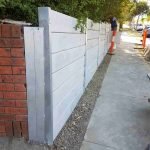Introduction
When it concerns enhancing your landscape, a durable and visually pleasing maintaining wall can make all the distinction. Whether you're seeking to prevent soil disintegration, develop a flat space in a sloping location, or simply include visual interest your property, employing the best retaining wall contractor is important. This guide will walk you through everything you need to know about finding, evaluating, and hiring a professional retaining wall installer.
What Is a Retaining Wall Contractor?
A retaining wall contractor focuses on the design and construction of retaining walls. These specialists understand different products-- like concrete sleepers, H beams, wood sleepers, wood sleepers, and stone-- and how to effectively use them for developing resilient structures that serve both functional and aesthetic purposes.
Why You Need a Retaining Wall Contractor
Expertise: An experienced specialist brings important understanding about soil types, drain options, and style principles that guarantee the wall's longevity.
Quality Materials: They have access to high-quality materials that might not be readily offered to the typical homeowner.
Regulations: Expert professionals are fluent in regional building codes and zoning laws.
The Benefits of Employing a Professional Retaining Wall Builder
Hiring a professional retaining wall builder has several benefits:
- Safety: Constructing walls needs an understanding of structural integrity; experts reduce risks. Time-Efficient: Specialists can complete tasks quicker due to their experience and expertise. Warranty Options: Lots of specialists use warranties on their work, providing assurance for homeowners.
Types of Keeping Walls
Understanding the various types of retaining walls can help you decide what finest fits your requirements:
1. Concrete Sleeper Walls
Concrete sleeper walls are prefabricated concrete panels that offer excellent toughness and strength.
2. H Beam Walls
H beam walls use steel beams for included support and are perfect for bigger structures.
3. Wood Sleeper Walls
These are more aesthetically pleasing but might need more maintenance with time compared to concrete options.
4. Timber Sleeper Walls
Timber uses a natural appearance but is prone to rot if not treated properly.
5. Stone Walls
Stone is frequently used for its charm however requires experienced labor for installation.
How to Select the Right Retaining Wall Installer
Choosing the right retaining wall installer includes several steps:
1. Research study Specialists in Your Area
Start by browsing online or asking next-door neighbors for recommendations. Search for reviews on platforms like Yelp or Google My Business.
2. Evaluate Their Experience
It's important to ask prospective professionals about their experience specifically with maintaining walls.
3. Examine Licensing and Insurance
Always validate that the specialist is certified and guaranteed; this safeguards you in case of mishaps throughout construction.
4. Ask for References
A trustworthy professional ought to be able to offer referrals from past clients who had similar projects completed.
Questions You Need to Ask Before Hiring
Before deciding, prepare questions that will provide you insights into their skills:
What is your experience with building keeping walls? Can I see examples of your previous work? How do you deal with drain issues? What products do you advise based upon my project needs? How long will my project draw from start to finish? Do you provide warranties or assurances on your work?Understanding Costs Involved in Structure Maintaining Walls
The expense of building a keeping wall can vary significantly based on numerous aspects:
- Material type (e.g., concrete vs wood) Wall height Site accessibility Labor rates
Here's an approximated breakdown of expenses by product type:
|Product Type|Expense per Square Foot|| --------------------|----------------------|| Concrete Sleeper|$30 - $50|| H Beam|$25 - $45|| Wood Sleeper|$15 - $30|| Timber Sleeper|$20 - $35|| Stone|$50 - $100|
The Necessary Guide to Employing a Retaining Wall Contractor: The Preparation Phase
Proper preparation can conserve you money and time down the line when working with your selected specialist:
1. Evaluate Your Needs
Consider why you require a maintaining wall-- whether it's erosion control, developing usable land, or visual enhancement.

2. Step Your Space
Accurate measurements guarantee that the design satisfies your requirements while adhering to local regulations.
3. Set a Budget
Understanding what you're willing to spend helps limit alternatives when talking about materials and styles with contractors.
Design Factors to consider When Working with a Retaining Wall Contractor
Design isn't practically appearances; it must likewise serve useful purposes:
1) Height
How high do you require the wall? Taller walls might need additional engineering considerations.
2) Drainage
Water management is crucial; inappropriate drainage options can lead to structural failure over time.
3) Visual Appeal
Consider incorporating landscaping components such as plants or ornamental stones into the style for visual appeal.
Legal Factors to consider When Constructing a Maintaining Wall
Many areas have specific guidelines regarding construction projects:
1) Regional Zoning Laws: Inspect if licenses are required before starting construction.

2) Home Lines: Guarantee that your new structure doesn't encroach on neighboring properties.
3) Environmental Regulations: Some areas have rules regarding landscaping near water bodies or secured areas.
FAQs About Employing A Retaining Wall Contractor
Here are some typical concerns people have about hiring a retaining wall contractor in addition to concise responses:
1) The length of time does it take to develop a maintaining wall?
https://tuffstuffretainingwalls.com.au/The timeline differs based upon size and intricacy but normally ranges from one day for little walls approximately numerous weeks for bigger installations requiring heavy equipment or substantial site preparation.
2) Do I need authorizations for building a maintaining wall?
Most municipalities need permits for constructing taller than 4 feet; constantly inspect local guidelines before continuing with construction.
3) Can I build my own retaining wall?
While DIY tasks are possible, it's advisable only if you're experienced in landscaping; working with professionals guarantees proper setup techniques are followed.
4) What products last longest?
Concrete sleeper walls usually last longer than wood choices due to their resistance versus decay; however, stone provides both resilience and charm if set up correctly.
5) How do I maintain my new retaining wall?
Regular inspections will help determine any issues early on; cleansing debris accumulation makes sure reliable drain while keeping track of cracks keeps them from intensifying over time.
6) Will my garden suffer throughout construction?
Most reliable specialists take preventative measures not just throughout installation however likewise later by bring back affected landscaping functions post-construction completion!
Conclusion
Finding the ideal retaining wall contractor does not need to be a frustrating process if you're geared up with understanding about what they do and how they run! The Essential Guide to Working with a Retaining Wall Contractor has provided insights into various elements-- from comprehending kinds of walls offered through examining expenses included-- all focused on helping house owners make informed choices when buying these critical outside structures! Always keep in mind-- when it comes down to protecting your property against soil disintegration while also boosting its visual appeal-- choosing wisely matters!